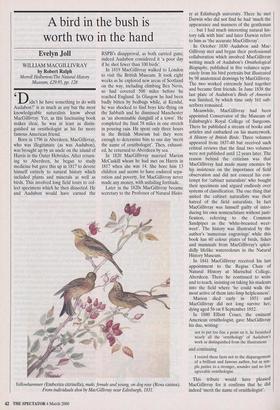A bird in the bush is worth two in the
hand
Evelyn Joll
WILLIAM MACGILLIVRAY by Robert Ralph Merrell Holberton/The Natural History Museum, £29.95, pp. 128 Didn't he have something to do with Audubon?' is as much as any but the most knowledgeable naturalists know about MacGillivray. Yet, as this fascinating book makes clear, he was at least as distin- guished an ornithologist as his far more famous American friend.
Born in 1796 in Aberdeen, MacGillivray, who was illegitimate (as was Audubon), was brought up by an uncle on the island of Harris in the Outer Hebrides. After return- ing to Aberdeen, he began to study medicine but gave this up in 1817 to devote himself entirely to natural history which included plants and minerals as well as birds. This involved long field tours to col- lect specimens which he then dissected. He and Audubon would have earned the RSPB's disapproval, as both carried guns; indeed Audubon considered it 'a poor day if he shot fewer than 100 birds'.
In 1819 MacGillivray walked to London to visit the British Museum. It took eight weeks as he explored new areas of Scotland on the way, including climbing Ben Nevis, so had covered 500 miles before he reached England. In Glasgow he had been badly bitten by bedbugs while, at Kendal, he was shocked to find boys kite-flying on the Sabbath and he dismissed Manchester as 'an abominable dunghill of a town'. He completed the final 58 miles in one stretch in pouring rain. He spent only three hours in the British Museum but they were enough to determine him to one day 'merit the name of ornithologist'. Then, exhaust- ed, he returned to Aberdeen by sea.
In 1820 MacGillivray married Marion McCaskill whom he had met on Harris in 1817 when she was 14. She bore him 13 children and seems to have endured sepa- ration and poverty, for MacGillivray never made any money, with unfailing fortitude.
Later in the 1820s MacGillivray became secretary to the Professor of Natural Histo- Yellowhammer (Emberiza citrinella), male, female and young, on dog rose (Rosa canina). From individuals shot by MacGillivray near Edinburgh, 1831. ry at Edinburgh university. There he met Darwin who did not find he had 'much the appearance and manners of the gentleman . . but I had much interesting natural his- tory talk with him' and later Darwin refers to him as 'the accurate MacGillivray'.
In October 1830 Audubon and Mac- Gillivray met and began their professional collaboration which involved MacGillivray writing much of Audubon's Ornithological Biography, published in five volumes sepa- rately from his bird portraits but illustrated by 98 anatomical drawings by MacGillivray. The two worked extremely hard together and became firm friends. In June 1838 the last plate of Audubon's Birds of America was finished, by which time only 161 sub- scribers remained.
Meanwhile, MacGillivray had been appointed Conservator of the Museum of Edinburgh's Royal College of Surgeons. There he published a stream of books and articles and embarked on his masterwork, A History of British Birds. Three volumes appeared from 1837-40 but received such critical reviews that the final two volumes were not published until 12 years later. The reason behind the criticism was that MacGillivray had made many enemies by his insistence on the importance of field observation and did not conceal his con- tempt for 'cabinet naturalists' who bought their specimens and argued endlessly over systems of classification. The one thing that united the cabinet naturalists was their hatred of the field naturalists. In fact MacGillivray was himself guilty of intro- ducing his own nomenclature without justi- fication, referring to the Common Sandpiper as the 'white-breasted weet- weet'. The history was illustrated by the author's 'numerous engravings' while this book has 60 colour plates of birds, fishes and mammals from MacGillivray's splen- didly lifelike watercolours in the Natural History Museum.
In 1841 MacGillivray received his last appointment to the Regius Chair of Natural History at Marischal College, Aberdeen. There he continued to write and to teach, insisting on taking his students into the field where 'he could walk the most active of them into limp helplessness'.
Marion died early in 1851 and MacGillivray did not long survive her, dying aged 56 on 8 September 1852.
In 1880 Elliott Coues, the eminent American ornithologist, gave MacGillivray his due, writing:
not to put too fine a point on it, he furnished nearly all the 'ornithology' of Audubon's work as distinguished from the illustrations
and continuing
I record these facts not to the disparagement of a brilliant and famous author, but in sim- ple justice to a stronger, sounder and no less agreeable ornithologist.
This tribute would have pleased MacGillivray for it confirms that he did indeed 'merit the name of ornithologist'.


































































 Previous page
Previous page